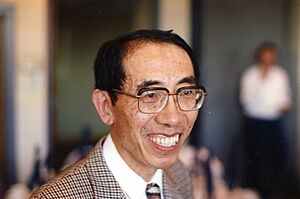Shoshichi Kobayashi facts for kids
Quick facts for kids
Shoshichi Kobayashi
|
|
|---|---|

Shōshichi Kobayashi in Berkeley
|
|
| Born | 4 January 1932 Kōfu, Japan
|
| Died | 29 August 2012 (aged 80) Kofu, Yamanashi, Japan
|
| Nationality | Japanese |
| Known for | Kobayashi–Hitchin correspondence Kobayashi metric |
| Awards | Geometry prize (1987) |
| Scientific career | |
| Fields | Mathematics |
| Institutions | University of California, Berkeley |
| Doctoral advisor | Carl B. Allendoerfer |
| Doctoral students |
|
Shoshichi Kobayashi (小林 昭七, Kobayashi Shōshichi, 4 January 1932 – 29 August 2012) was a famous Japanese mathematician. He was known for his work on complex and Riemannian manifolds. These are special kinds of spaces in mathematics. He also studied how geometric shapes can change and Lie algebras, which are important in advanced math.
Contents
Life and Education
Shoshichi Kobayashi was born in Kōfu, Japan, in 1932. He was the older brother of Hisashi Kobayashi, who became a well-known electrical engineer.
Shoshichi loved math from a young age. He went to the University of Tokyo and finished his studies there in 1953.
Becoming a Doctor of Math
He then moved to the United States to continue his education. In 1956, he earned his Ph.D. (a very high degree) from the University of Washington. His main teacher there was Carl B. Allendoerfer.
His Ph.D. paper was called Theory of Connections. After getting his Ph.D., he spent time at two other important places: the Institute for Advanced Study and MIT.
Working at Berkeley
In 1962, Kobayashi joined the University of California, Berkeley. He started as an assistant professor. He quickly showed how brilliant he was.
The very next year, he was given "tenure," which means he had a permanent job. By 1966, he became a full professor.
He even led the Berkeley Mathematics Department for a few years. He was the chairman from 1978 to 1981 and again in 1992. He retired early in 1994.
His Big Ideas in Math
Kobayashi made many important contributions to mathematics. He wrote a very influential two-volume book called Foundations of Differential Geometry with Katsumi Nomizu. This book helped many students and researchers.
In 1970, he was invited to speak at a big math conference in Nice, France. This showed how respected he was in the math world.
Understanding Complex Shapes
Much of his early work was about the geometry of "connections" on special mathematical structures. These ideas were later included in his famous book.
He also worked on something called the "Kobayashi metric". This is a special way to measure distances on complex shapes. It helps mathematicians understand how these shapes behave.
The Kobayashi metric led to the idea of "Kobayashi hyperbolicity." This is a way to describe if a complex shape is "hyperbolic," which means it has certain properties. He used these ideas to create a more advanced version of a well-known math rule called the "Alhfors–Schwarz lemma."
Connecting Geometry and Algebra
Another important idea he worked on was the "Kobayashi–Hitchin correspondence." This is a deep connection between two different areas of math: geometry and algebra.
He showed that certain geometric properties of shapes have important meanings in algebra. This was a big step forward in understanding these complex relationships. Other mathematicians, like Karen Uhlenbeck and Shing-Tung Yau, built on his work.
Major Publications
Kobayashi wrote many important articles and books. His book Foundations of Differential Geometry is still widely used today. He also wrote several textbooks in Japanese.
See also
 In Spanish: Shoshichi Kobayashi para niños
In Spanish: Shoshichi Kobayashi para niños

